- AI Fire
- Posts
- 🎙️ My AI Hack: Turn YouTube Videos Into A Personal Audio Lesson
🎙️ My AI Hack: Turn YouTube Videos Into A Personal Audio Lesson
Feeling lost learning online? This article shows how to use AI to organize videos into a clear curriculum and a custom audio lesson. Learn any topic fast.

Poll: What's your BIGGEST challenge when learning something new online? 🤔 |
Table of Contents
Introduction
Have you ever tried to learn a new skill and felt completely lost? You start by searching online, and suddenly, you have 20 tabs open. You watch a few videos, read some articles, but the information is all over the place. Some of it is too simple, and some of it is way too complicated. After a few hours, you feel more confused than when you started. You have a lot of puzzle pieces, but you don't know how to put them together.

This is a common problem. Most information online is not created to be a step-by-step course. It's just a collection of separate ideas. To learn well, you need a clear path, a roadmap that takes you from the beginning to the end in a logical order. But making that roadmap yourself can be very difficult and take a lot of time.
Luckily, there is a new way to solve this problem using Artificial Intelligence (AI).
In this article, I will show you a simple method to use AI tools to learn any topic you want, much faster than before. Whether you want to learn about a new technology, understand personal finance, or pick up a new hobby, this method will help you cut through the confusion. It helps you build a clear learning path based on reliable information you choose.
The best part is that you don't need any special technical skills. The process is straightforward, the tools are free to get started, and it works for almost any subject you can think of.
Let's begin.
Why Learning On Your Own Can Be So Hard
Before we look at the AI solution, let's understand the problem a little better. Why is self-learning from the internet often so frustrating?

Too Much Information: When you search for a topic, you get millions of results. It’s like trying to drink water from a firehose. You don't know where to look first, and it's easy to feel overwhelmed.
No Clear Path: The internet doesn't give you a curriculum. You might find a great article about an advanced part of your topic, but you haven't learned the basics yet. It’s like trying to read Chapter 10 of a book before you've read Chapter 1.
Wasted Time: You often click on a link that looks promising, which leads you to another link, and then another. Before you know it, you've spent an hour going down a "rabbit hole" and haven't learned the main thing you wanted to.
Information Isn't Connected: You might learn one fact from a video and another fact from a blog post, but you don't understand how they relate to each other. Learning isn't just about collecting facts; it's about connecting them to build a bigger picture.
Content Isn't for You: A lot of content is made for experts, while other content is too basic. It’s hard to find information that is at exactly the right level for you.
These problems make learning feel like a full-time job. Instead of focusing on learning the actual topic, you spend most of your energy just trying to organize the information. This is where AI can make a huge difference.
Learn How to Make AI Work For You!
Transform your AI skills with the AI Fire Academy Premium Plan - FREE for 14 days! Gain instant access to 500+ AI workflows, advanced tutorials, exclusive case studies and unbeatable discounts. No risks, cancel anytime.
What You Will Need
To follow this method, you only need a few simple things. Most of them are probably already on your computer.
A topic you are curious about - Anything you want to learn!
YouTube - We will use this to find expert videos on your topic.

NotebookLM - This is the special AI tool from Google that will act as your personal learning assistant.
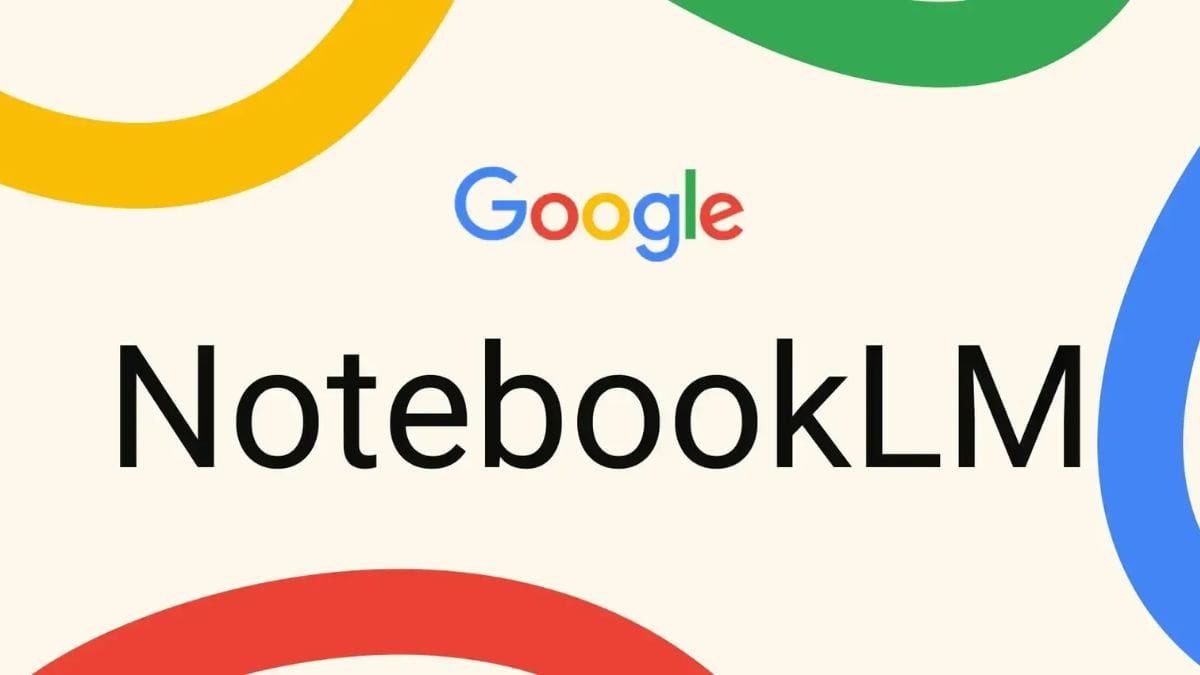
A web browser - Like Chrome, Firefox, or Safari to access these websites.
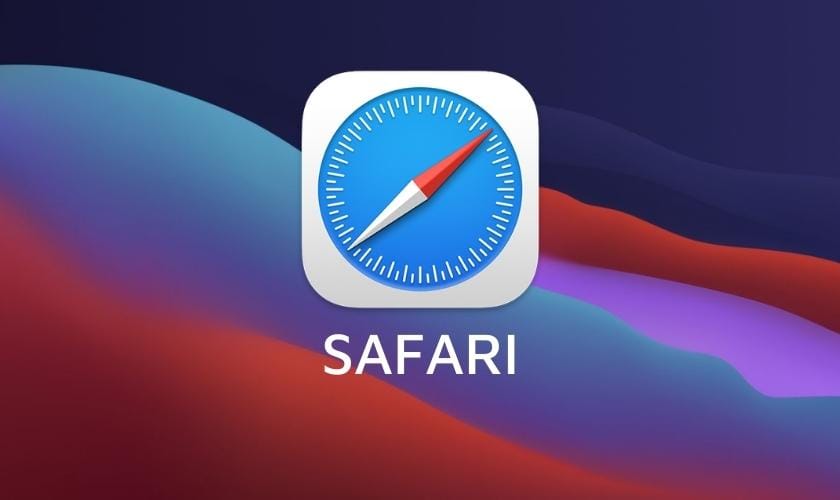
You can get started with NotebookLM for free. Just visit their website and sign in with your Google account. It's a very powerful tool that we will use to do all the heavy lifting.
Step 1: Find Good Video Lessons On Your Topic
The first step is to gather your learning materials. The quality of your learning experience will depend on the quality of the materials you give the AI. So, we want to find the best videos we can.

Let’s imagine you want to learn a new topic. For our example, let's choose "how to start investing in the stock market for beginners." This is a popular topic with a lot of information online, so it's a perfect candidate for this method.
How to Search on YouTube
Go to YouTube and search for your topic. Be specific. A search like "stock market for beginners" or "how to buy your first stock" is much better than just "investing."
What to Look for in a Good Video:

Recent Upload Date: For topics like finance or technology, things change quickly. Look for videos that were published in the last year or two to make sure the information is up-to-date.
Good Number of Views: A video with many views (for example, 50,000+) is often a sign that people find it helpful. It's not always true, but it's a good starting point.
Credible Creator: Who made the video? Is it a channel that focuses on finance and investing? A creator with a good reputation in a specific field is usually a better source than a random channel.
Helpful Comments: Take a quick look at the comments section. Are people saying the video was clear and useful? This is a great way to check the quality before you even watch it.
Clear Title: The title should accurately describe what the video is about. Avoid videos with dramatic, clickbait titles like "GET RICH IN 5 MINUTES!"
Collect the URLs of the Videos
Your goal is to collect between 5 and 10 video links. This gives the AI enough information to see different perspectives and explanations, creating a more complete learning experience.
For each video that looks good, do the following:
Click the "Share" button below the video player.
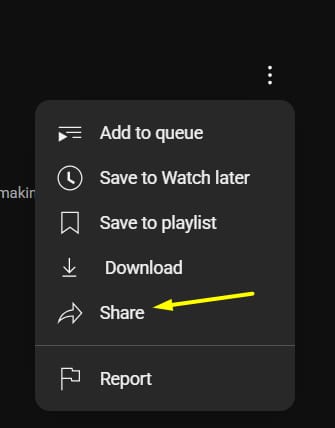
A small window will pop up. Click the "Copy" button to copy the video's URL (its web address).
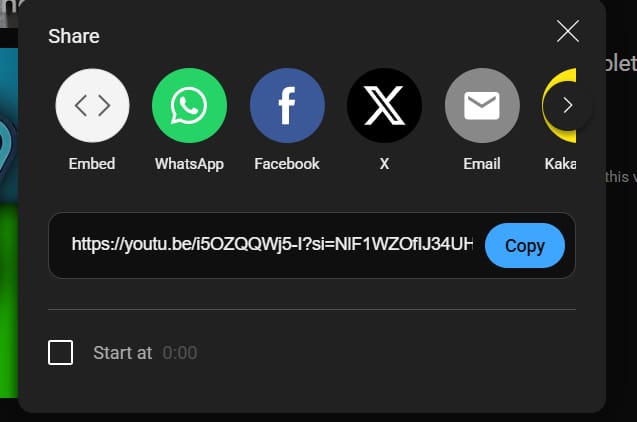
Paste this link into a simple text file or notepad on your computer so you can easily find it later.
Spend about 10-15 minutes on this step. Finding good sources is the most important part of the process. Good sources lead to a good learning outcome.
Step 2: Prepare Your AI Learning Space In NotebookLM
Now that you have your list of high-quality video links, it’s time to set up your personal AI assistant.
Open NotebookLM
Go to the NotebookLM website. If it's your first time, you'll need to sign in with your Google account.
Create a New Notebook
Click on the button that says "Create New Notebook."
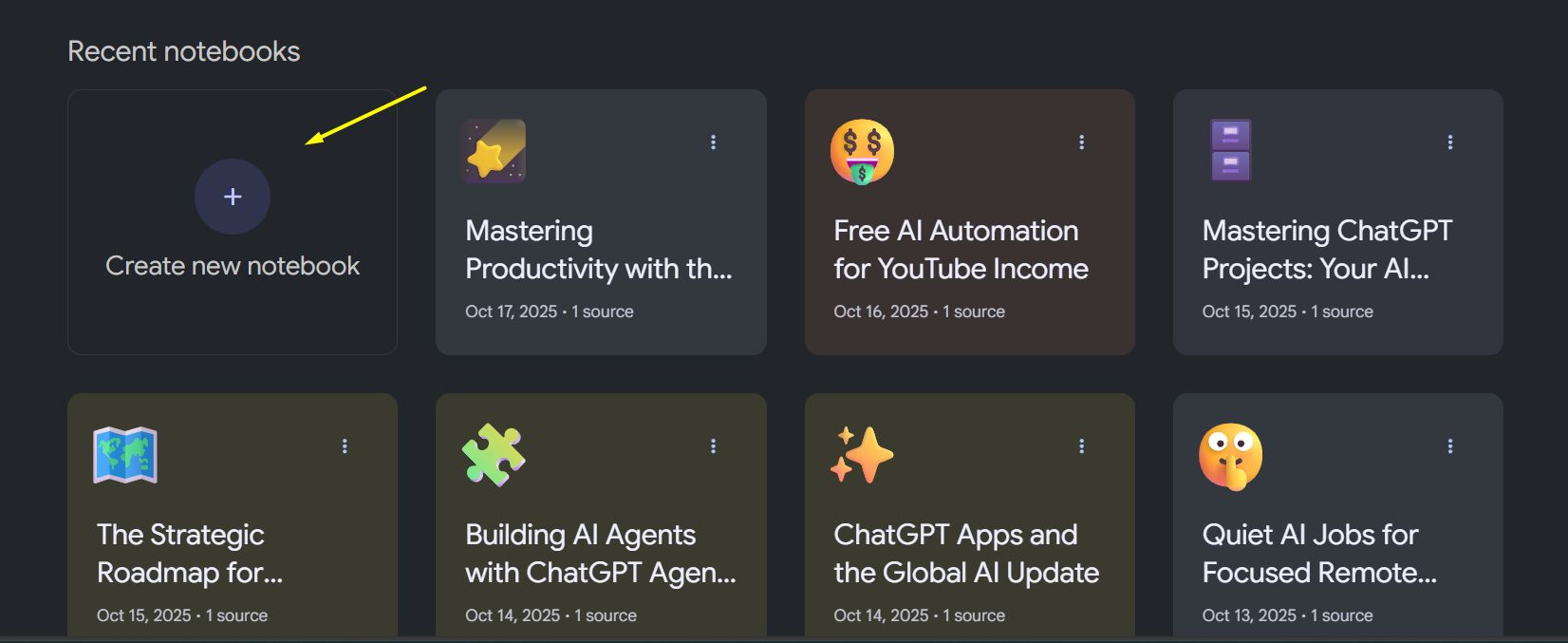
Think of a notebook as a dedicated project folder for one specific topic. If you want to learn about stock market investing, you create one notebook. If you later decide to learn about digital photography, you create a different notebook. This keeps everything clean and organized. Give your notebook a clear name, like "Stock Market Basics."
Add Your Videos as Sources
On the left side of the screen, you will see a "Sources" area with a plus (+) button. This is where you will add all the YouTube URLs you collected.
Click the plus button and choose the "YouTube" option.
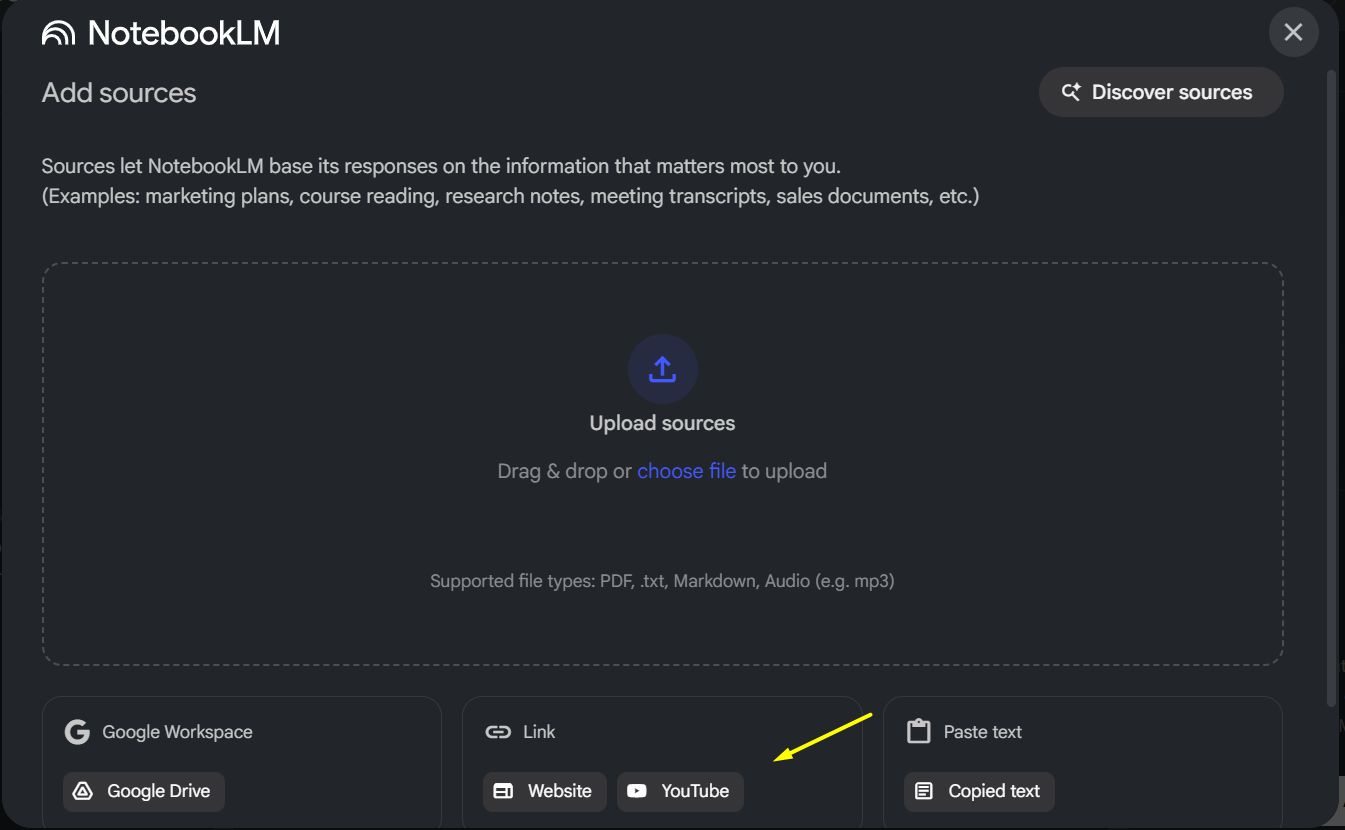
A box will appear asking for a YouTube URL. Go to your text file, copy the first video link, and paste it here.
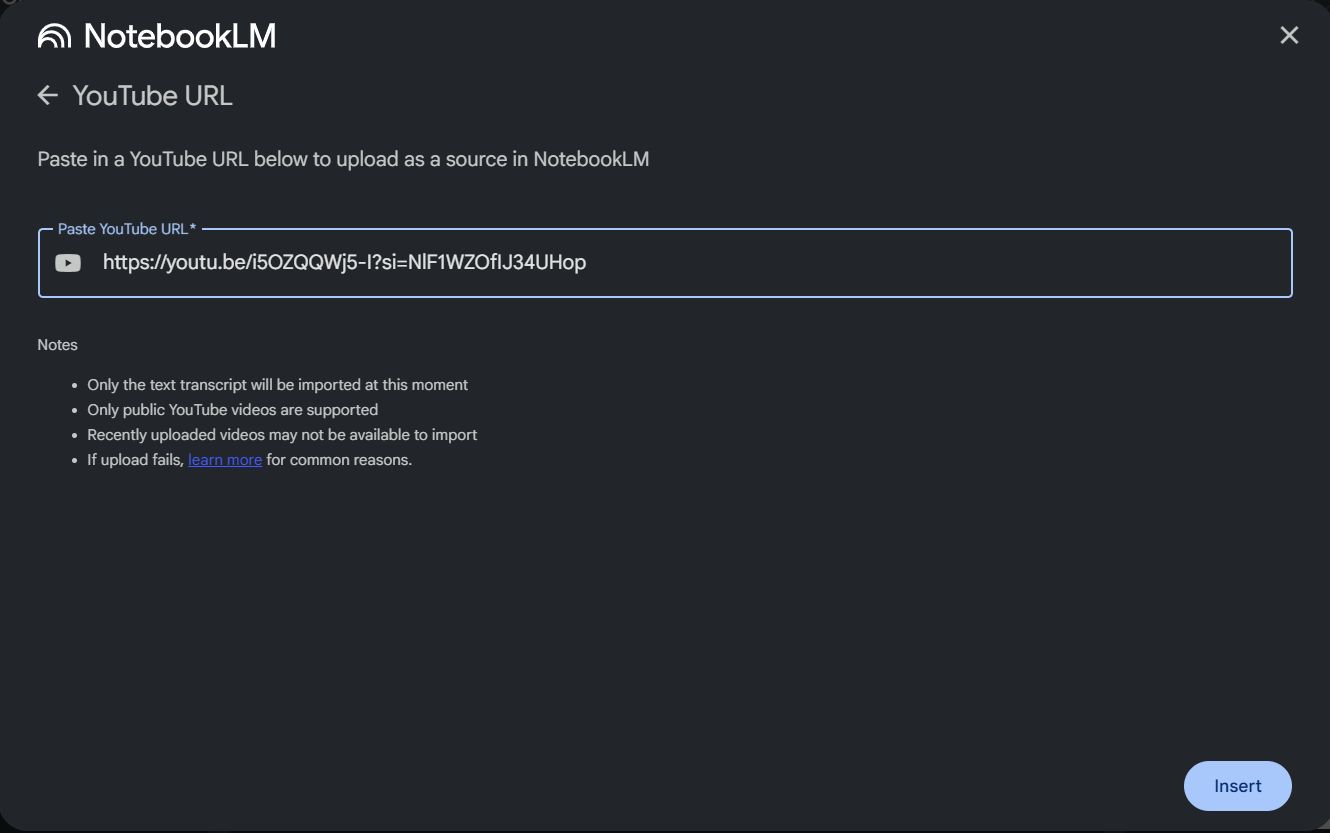
Press Enter. NotebookLM will take a few seconds to process the video. It is "watching" the video and reading its transcript to understand everything that was said.
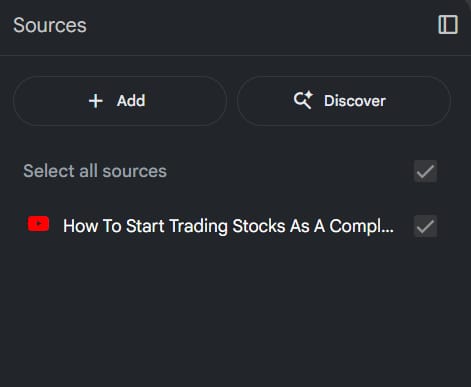
Once it's done, you'll see the video title appear in your Sources list.
Repeat this process for all the other video links you collected. Add them one by one.
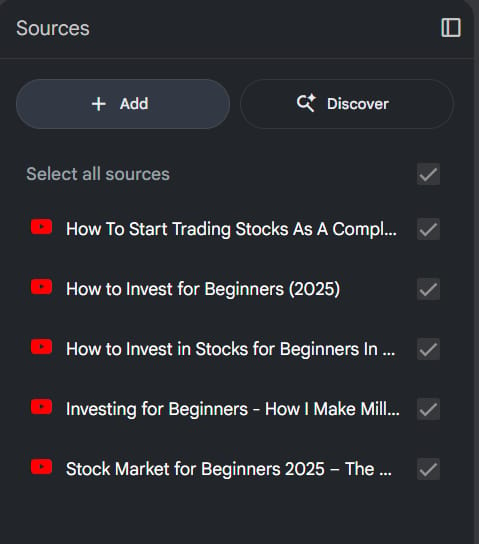
When you're finished, you will have a list of 5-10 videos in your Sources panel. NotebookLM has now absorbed all the knowledge from those videos and is ready to help you.
Step 3: Ask The AI To Build Your Personal Learning Plan
This is where the process becomes truly powerful. Instead of watching those videos in a random order, you will ask the AI to act like a personal teacher and create a logical, step-by-step curriculum for you.
Write a Prompt to Create an Outline
At the bottom of the NotebookLM screen, there is a chat box. This is where you can talk to the AI. You need to give it a clear instruction, which we call a "prompt."
Here is an example of a good, simple prompt:

"Based on all the videos I've added, create a simple course outline for someone who knows nothing about the stock market. Organize it in a logical, step-by-step way."
You can also be more specific. Here’s a slightly more advanced prompt:

"I am a complete beginner in finance. Using the information from the provided videos, generate a detailed learning plan about stock market investing. The plan should cover the essential concepts first, then move on to practical steps for getting started. Make sure to include a section on common beginner mistakes to avoid."What Happens Next
After you enter your prompt, the AI will read it, analyze all the video content in your sources, and generate a structured outline for you in just a few seconds.
The outline might look something like this:
Learning Plan: Stock Market Investing for Beginners
The goal of this plan is to cut out unnecessary confusion and provide a complete A-Z guide for starting to invest.
Module 1: The Essential Foundations (The What and Why)
This module focuses on the philosophy of investing and why it is a necessary part of financial planning.
1. Understanding the Purpose of Investing:
◦ The core point of investing is for your existing money to make more money.
◦ Investing is a safe and smart way to grow your money, and it should not be treated as a get-rich-quick scheme.
2. The Threat of Inflation:
◦ Inflation causes money to lose its purchasing power over time (e.g., a $100 bill will buy less in the future).
◦ Unless your money is earning at least the inflation rate (which has recently been 5% to 8%), your money is losing value just sitting in a savings account. Investing helps combat this effect.
3. The Power of Compound Interest:
◦ Compound interest is the interest you earn on your previously earned interest.
◦ This effect is the engine that helps your money grow "magically on its own".
◦ Leveraging compound interest and time is key to growing wealth significantly faster than traditional saving.
4. Historical Market Performance:
◦ The S&P 500 (an index tracking the top 500 US companies) has been consistently trending upward.
◦ Historically, stocks have produced the best returns over the past 100 years compared to other assets.
◦ The S&P 500 has provided an average annualized return of around 8% to 10% per year since its inception.
Module 2: Key Concepts and Terminology
Before investing, a beginner must understand the basic language of the market.
1. Defining Stocks and Shares:
◦ A stock refers to the business you are investing in or have ownership in.
◦ A share is the smallest amount of stock you can own, representing a percentage ownership in a company.
2. How Stocks Generate Returns:
◦ Price Appreciation (Capital Gains): Making money by hoping the stock's value rises over time so you can sell it later for a higher price.
◦ Dividends: A portion of the company's profits paid out to shareholders, similar to rental income from a house.
3. Market Lingo:
◦ Market Capitalization (Market Cap): Refers to the size and valuation of a company (calculated by share price multiplied by shares in circulation).
◦ Index: A scoreboard that tracks the performance of a group of pre-selected investments (e.g., S&P 500, NASDAQ 100).
◦ Bull vs. Bear: Being bullish means having a positive outlook and expecting prices to rise; being a bear means having a negative outlook and expecting prices to fall.
◦ Blue Chip Stock: An excellent, stable, typically large company stock.
4. Investment Vehicles for Beginners:
◦ Individual Stocks: Buying one specific company; this is exciting but much riskier and volatile.
◦ Index Funds/ETFs (Exchange Traded Funds): A fund (or basket) of stocks that tracks a specific market index (e.g., the S&P 500). Index funds are passively managed, result in super low fees, and provide instant diversification across hundreds of companies with a single purchase.
Module 3: Practical Steps for Getting Started
This module outlines the pre-investment checklist and initial execution steps.
1. Financial Readiness Checklist:
◦ Pay off high-interest debt: Prioritize paying off any debt where the interest rate is greater than 10%.
◦ Establish a safety net: Have an emergency fund covering 3 to 5 months of living expenses.
◦ Determine Time Horizon: Decide if you are investing short-term (under 3 years, which increases risk and taxes) or long-term (over 3 to 5 years, which is less stressful and comes with less volatility and taxes).
◦ Determine Risk Profile: Identify whether you are riskier or more conservative, as different assets (stocks, bonds, cash) suit different risk tolerances.
2. Crucial Step: Start with $0 and Practice:
◦ The answer to how much money you need to start trading is $0.
◦ Use trading simulators or paper trading (platforms like Webull or Trading 212 offer this) to test strategies with fake money.
◦ The trick is to act like this fake money is your actual capital.
◦ Record every trade, noting what you did wrong (greed, moving stop loss, emotions) and what you did right, to exponentially speed up your learning process.
◦ Initially, focus purely on improving your trading strategy and learning, not on the money aspect.
3. Selecting a Strategy (The Safe Approach):
◦ Passive Funds Strategy: This is the easiest way to enter the market.
▪ Invest in Index Funds/ETFs: This gives you exposure to a diversified portfolio (e.g., 500 top US companies) with one purchase.
▪ Dollar Cost Averaging (DCA): Consistently invest a fixed amount of money (e.g., $200 every month) regardless of the stock price. This minimizes the cost per share over time and stops the psychological fear of trying to time the market.
4. Setting up Your Account:
◦ You need an investment platform or brokerage account (e.g., Fidelity, Trading 212, Moomoo, Charles Schwab) to buy stocks; you cannot buy them directly through a bank account.
◦ Consider opening a tax-advantaged account first, such as a Roth IRA (US) or Stocks and Shares ISA (UK), because all your earnings within these accounts are tax-free.
◦ Deposit funds into your brokerage account.
5. Placing Your First Investment Order:
◦ Search for the fund or stock you want to buy (e.g., an S&P 500 ETF ticker symbol like VOO).
◦ Choose your Order Type:
▪ Market Order: Buy or sell immediately at the current market price.
▪ Limit Order: Buy or sell only when the stock reaches a specified price or better.
◦ Enter the quantity of shares, or the dollar amount if the platform offers fractional shares.
Module 4: Common Beginner Mistakes to Avoid
Understanding where new investors typically fail is vital for long-term success.
1. Skipping the Simulation/Paper Trading Phase: Instantly jumping into the market with real money without any experience is the biggest mistake, often leading to losing all capital and quitting forever.
2. Trying to Pick Individual Stocks: For beginners, trying to select individual stocks is strongly discouraged, as the average person is unlikely to beat the returns gained by simply investing in an index fund. Very few professionally managed funds reliably outperform the S&P 500.
3. Investing for the Short Term: Short-term investing (under 3 years) comes with high risk, high volatility, and significantly higher taxes. Short-term capital gains (selling a stock held for under one year) are taxed at your ordinary income rate, which is higher than the long-term capital gains rate.
4. Trying to Time the Market: You cannot tell the future, and trying to guess when the market will hit a high or a low often results in missing the best days of gains. The best strategy is to just keep buying (DCA) and stay invested.
5. Letting Emotions Dictate Decisions: Panicking and selling during market crashes or recessions is a major mistake. If you sell when the price is low, you realize the loss; if you just hold your investment, history shows the market tends to recover and broadly goes up over a long enough time horizon.
6. Failing to Analyze Results: Not recording and analyzing your winning and losing trades (and the reasons behind them, such as greed or failing to follow a rule set) will prevent you from improving your strategy.
7. Following the Hype: Blindly following popular, volatile stocks (like the example of Nokia) is dangerous, as the past performance of individual stocks does not guarantee future results. Investing in a diversified fund is safer because if one company fails, your money is spread across hundreds of others.Copy the Outline
Select all the text of the outline the AI created and copy it. You're going to need it for the next, very exciting step.
Step 4: Turn Your Learning Plan into a Personal Audio Lesson
Reading an outline is helpful, but what if you could listen to a personalized lesson that explains it all to you? NotebookLM has a special feature that can turn your sources and your outline into an audio conversation, like a mini-podcast.
Find the "Audio Overview" Feature

In your notebook, you should see a feature that allows you to generate audio. It might be a button or an icon that looks like a sound wave.
Important: Give the AI Specific Instructions
If you just click the "generate" button without any guidance, the AI will create a general summary of your videos. We want it to be more specific. We want it to follow the beautiful learning plan it just created for you.

Look for an "edit" or "options" icon (it often looks like a pencil or a slider) next to the generate button. Click it. This will open a text box where you can give instructions.
Here's what you should write. It’s a very simple formula:
Tell the AI what to do.
Paste the outline you copied.
Here’s a clear example prompt:

"Create a friendly and easy-to-understand audio conversation for a beginner learning about the stock market. The conversation should be between two hosts who explain the topic."Generate Your Custom Audio Lesson
After you've pasted your instructions and the outline, click the "Generate" button.

This process can take between 5 and 15 minutes. Be patient. Behind the scenes, the AI is doing a lot of work:
It's reviewing all your video sources again.
It's carefully following your custom curriculum, step by step.
It's writing a script for a conversation between two AI hosts.
It's generating realistic, human-sounding voices for those hosts.
It's making sure the conversation flows naturally from one point to the next.
What You Get

When it's finished, you will have a 10-20 minute audio file. It's a full lesson, created just for you. The two AI hosts will have a conversation that covers all the points in your outline, explaining complex ideas in simple terms, using examples from the videos you provided.
You can listen to this audio lesson while you are driving, cleaning your house, or going for a walk. It's an incredibly efficient way to learn.
Step 5: Active Learning With Your AI-Generated Content
You now have a custom-made audio lesson. To get the most out of it, you need to be an active listener.
Listen Carefully

The first time you listen, just pay attention. Don't worry about taking notes yet. The conversation is designed to guide you through the topic logically. Notice how it follows the curriculum you generated.
Take Notes on Key Ideas
Listen to it a second time, but this time, have a pen and paper (or a digital note-taking app) ready. Pause the audio whenever you hear an important point and write it down. Focus on:
Definitions of new words (e.g., "What is an ETF?").
Key concepts (e.g., "Diversification is important because...").
Actionable steps (e.g., "Steps to open a brokerage account...").
Any questions you have.
Ask Follow-Up Questions
This is another powerful feature of NotebookLM. After listening, you might still have some questions. You can ask them directly in the chat box!
For example, you could ask:

"Can you explain the difference between a Roth IRA and a 401(k) in simple terms?"
"Based on the sources, what are the top 3 recommended brokerage platforms for beginners?"
"Create a simple table comparing stocks and ETFs."
The AI will answer your questions using only the information from the videos you provided. This is like having a personal tutor who you can ask questions to at any time.

Go Further With Other AI Features
Your AI learning assistant can do more than just create outlines and audio lessons. Here are some other things you can ask it to do to help you learn even better. For each one, just type your request into the chat box.
Create a Study Guide
A study guide summarizes the most important information in a condensed format.
Prompt Idea:

"Generate a one-page study guide or 'cheat sheet' for stock market investing beginners. It should include key terms, important concepts, and a checklist for getting started."
Make Flashcards
Flashcards are great for memorizing key terms and definitions.
Prompt Idea:

"Create a set of 10 flashcards from the source videos. Each card should have a term on one side (like 'Dividend') and a simple definition on the other."
Generate a Mind Map
If you are a visual learner, seeing how ideas connect can be very helpful.
Prompt Idea:

"Create a mind map that shows the main concepts of beginner investing and how they relate to each other. Start with 'Stock Market Investing' in the center."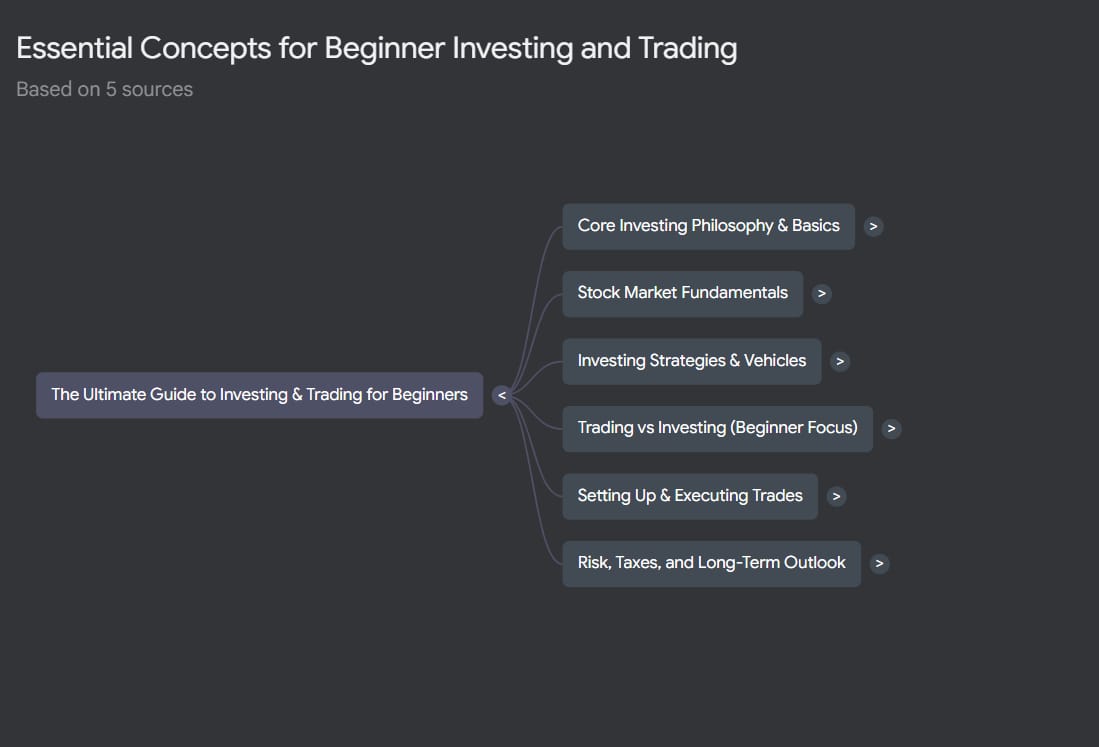
Create a Quiz to Test Your Knowledge
The best way to know if you've learned something is to test yourself.
Prompt Idea:

"Make a 5-question multiple-choice quiz based on the information in the videos to test my understanding of the basics. Provide the answers at the end."
Generate a List of Frequently Asked Questions (FAQs)
This can help you understand common questions and concerns that other beginners might have.
Prompt Idea:

"Based on the content of these videos, create an FAQ list with answers to the 5 most common questions a beginner might have about starting to invest."
Tips For Getting The Best Results
Following this method will give you good results, but these tips can make your learning experience even better.

Be a Good Curator: The phrase "garbage in, garbage out" is very true for AI. The quality of your learning depends entirely on the quality of your sources. Spend a little extra time finding clear, accurate, and up-to-date videos.
Use 5-10 Sources: Don't use just one or two videos. This might give you a narrow or biased view. Using 5-10 different sources gives the AI a more balanced perspective and helps you get a more complete picture of the topic.
Give Clear Instructions: The more specific you are with your prompts, the better the AI's response will be. Tell it who you are (e.g., "I am a complete beginner") and what you want (e.g., "a step-by-step plan," "a simple explanation").
Combine AI Learning with Practice: This method is fantastic for understanding theories and concepts. But for skills, you need to practice. If you're learning about investing, the next step is to open a practice account. If you're learning to code, you need to write code.
Stay Organized: Keep your notebooks well-named and organized. Over time, you can build a personal library of custom-made learning materials for every topic you are interested in.
A New Way Of Learning

This method is more than just a trick to learn faster. It points to a new and exciting future for education, where learning is more personal and accessible.
Traditionally, education is often "one-size-fits-all." Everyone in a class learns the same thing at the same speed. It can be expensive and not very flexible.
AI-powered learning changes this. It gives you:
A Custom Curriculum: You get a learning plan designed specifically for your needs and your questions.
Your Own Pace: You can learn whenever you want, and you can review difficult concepts as many times as you need.
Low Cost: The tools to do this are free.
Complete Flexibility: You are in control. You choose the topic, you choose the sources, and you direct the learning process.
We are moving into an age where anyone can become their own "curriculum designer." You are no longer just a passive student waiting to be taught. You can actively build your own learning journeys.
Some Limitations To Keep In Mind
To be fair, this method isn't perfect. Here are a few things to be aware of:

AI Can Make Mistakes: Although it's rare, the AI can sometimes misunderstand a concept from a video or make a small error. If something sounds strange, you can always go back to the original source video to double-check.
It's Based on Your Sources: The AI cannot know anything outside of the sources you provide. If your videos are all from one person with a strong opinion, your learning materials will reflect that opinion. This is why choosing a variety of credible sources is so important.
It's for Conceptual Learning: This method is excellent for understanding ideas, theories, and processes. However, for hands-on skills like playing a musical instrument or learning a sport, you will still need to do the physical practice.
Conclusion
Learning something new no longer has to be a slow, frustrating, and disorganized process. By using a powerful AI tool like NotebookLM, you can take control of your education.
The method is simple and effective:
Find 5-10 high-quality YouTube videos on your chosen topic.
Add them as sources to a new notebook in NotebookLM.
Ask the AI to create a custom, step-by-step learning outline for you.
Use that outline to generate a personal audio lesson that explains everything clearly.
Listen, take notes, and ask follow-up questions to deepen your understanding.
This approach saves you countless hours of random searching and helps you build real, connected knowledge instead of just collecting isolated facts. You can create a structured learning experience for any topic in under an hour.
The tools are ready and waiting for you. All you need to bring is your curiosity.
What is something you have always wanted to learn? Give this method a try today. You will be amazed at how quickly and effectively you can learn something new.
If you are interested in other topics and how AI is transforming different aspects of our lives or even in making money using AI with more detailed, step-by-step guidance, you can find our other articles here:
Mastering Midjourney V6: 8 Insider Prompting Tricks That Feel Illegal to Know*
Fully Detailed & Powerful Instruction That Drive Custom GPTs/ Projects/ Gems
Easy Guide to Writing Effective Al Prompts for Better Results*
Stop "Prompting" AI Coding Assistants! Do THIS Instead
*indicates a premium content, if any
How useful was this AI tool article for you? 💻Let us know how this article on AI tools helped with your work or learning. Your feedback helps us improve! |
Reply